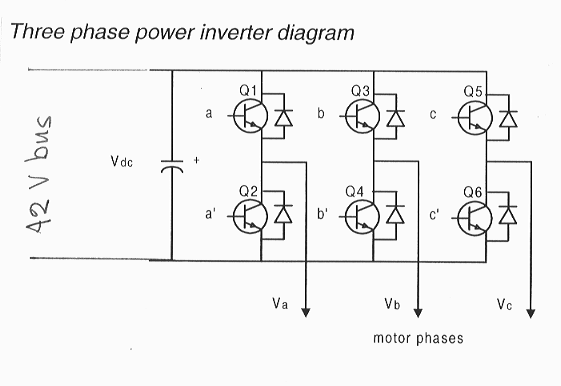Designing a quieter pulse-width-modulation algorithm*
Future
automotive electrical systems will be operating at
42 Volts DC, rather than the present nominal 13.8
Volts. Advanced applications in the modern automobile
require this rise in operating voltage, such as active
suspensions, hemetically sealed air-conditioning motor/compressors,
hybrid Diesel/electric power trains, and other advanced
intelligent systems.
The
electric motors of these applications will require
3-phase AC current at 42 Volts. The conversion from
the 42 Volt DC bus to 3-phase AC is done by
power inverters, processor driven FET switches (usually
6 in number) that synthesize the AC voltage.
Let
us look at the simplest possible case --- let us synthesize
some nonnegative voltage wave form v(t) < 42 using
one switch:

We
partition time into small intervals of length T whereupon
the desired signal v(t) is more or less constantly
v. The processor then closes the switch for only a
portion dt of this interval T so that the energy
drawn from the battery during dt equals the energy
that would be supplied during the whole interval T
were the voltage to be v, i.e.,
T v^2 = dt 42^2.

In
other words, the switch doles out average current
as if the voltage were v. This is pulse-width-modulation
(PWM). The switch is intelligently driven by a processor
that monitors the smoothed voltage across the load
R and varies the width dt of the pulse so as to synthesize
the desired voltage v(t).
But
the 42 Volt DC bus will suffer from such abuse ---
it is being asked to deliver current in a train of
square waves. These waves induce voltage drops across
the inductance of the wires coming from the battery,
create radio noise, stress the alternator, and
generally degrade the power quality of the DC bus,
affecting the performance or even damaging other components
at other locations in the automobile. The standard
remedy is to hang large electrolytic capacitors across
the DC bus as it enters the power inverter to serve
as current sources or sinks, thus smoothing
the train of current demands. These capacitors are
large, expensive, and cannot endure well the 120C
temperatures found in an engine compartment.
The
problem is to redesign the PWM algorithm to minimize
the number of electrolytic capacitors.
In
more detail, the inverter supplies 3-phase AC
(three 42 Volt sinusoidal voltages shifted in phase
0, 120, and 240 degrees) by pulse-width modulating
6 field effect transistors (FET):

These
6 FETs are to be switched according to some algorithm
to be designed by the team. McCleer Power will specify
the response of the load and the required bus power
quality. With the load response in hand, one
can predict the current waveform demanded from the
DC bus. Using the standard description of electrolytics
it is then possible to model the improvement in demand
from adding each electrolytics in turn across the
bus. Conceivably a large automated search will find
an algorithm for which the specified power quality
is reached with the minimum number of electrolytic
capacitors. Such a switching algorithm would be of
deep interest to the automobile industry.
A
proof-of-concept for a simple two FET, single-phase
inverter would be a sufficient (and significant) deliverable.
Back
To the Top